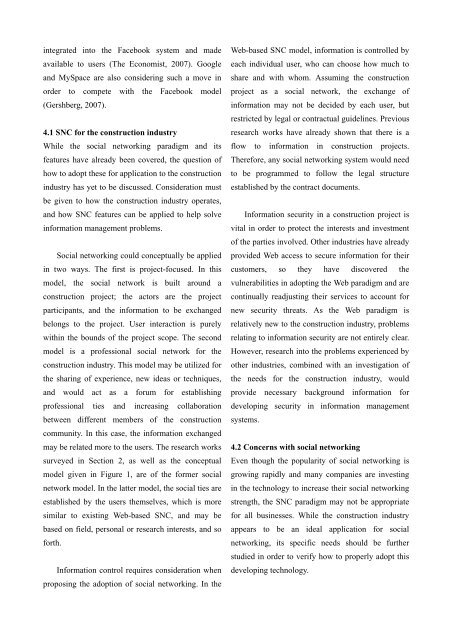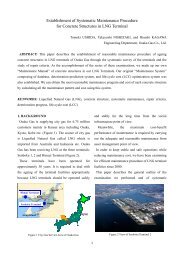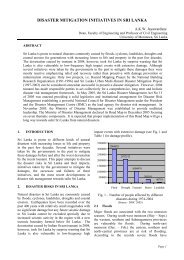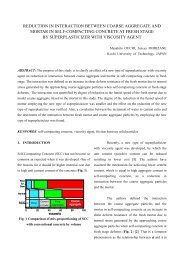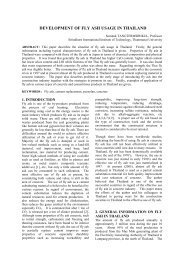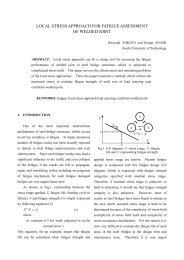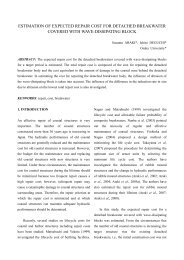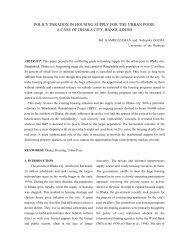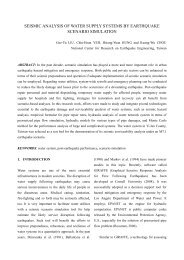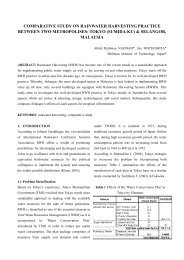PAPER FORMAT FOR THE INTERNATIONAL SYMPOSIUM on ...
PAPER FORMAT FOR THE INTERNATIONAL SYMPOSIUM on ...
PAPER FORMAT FOR THE INTERNATIONAL SYMPOSIUM on ...
You also want an ePaper? Increase the reach of your titles
YUMPU automatically turns print PDFs into web optimized ePapers that Google loves.
integrated into the Facebook system and made<br />
available to users (The Ec<strong>on</strong>omist, 2007). Google<br />
and MySpace are also c<strong>on</strong>sidering such a move in<br />
order to compete with the Facebook model<br />
(Gershberg, 2007).<br />
4.1 SNC for the c<strong>on</strong>structi<strong>on</strong> industry<br />
While the social networking paradigm and its<br />
features have already been covered, the questi<strong>on</strong> of<br />
how to adopt these for applicati<strong>on</strong> to the c<strong>on</strong>structi<strong>on</strong><br />
industry has yet to be discussed. C<strong>on</strong>siderati<strong>on</strong> must<br />
be given to how the c<strong>on</strong>structi<strong>on</strong> industry operates,<br />
and how SNC features can be applied to help solve<br />
informati<strong>on</strong> management problems.<br />
Social networking could c<strong>on</strong>ceptually be applied<br />
in two ways. The first is project-focused. In this<br />
model, the social network is built around a<br />
c<strong>on</strong>structi<strong>on</strong> project; the actors are the project<br />
participants, and the informati<strong>on</strong> to be exchanged<br />
bel<strong>on</strong>gs to the project. User interacti<strong>on</strong> is purely<br />
within the bounds of the project scope. The sec<strong>on</strong>d<br />
model is a professi<strong>on</strong>al social network for the<br />
c<strong>on</strong>structi<strong>on</strong> industry. This model may be utilized for<br />
the sharing of experience, new ideas or techniques,<br />
and would act as a forum for establishing<br />
professi<strong>on</strong>al ties and increasing collaborati<strong>on</strong><br />
between different members of the c<strong>on</strong>structi<strong>on</strong><br />
community. In this case, the informati<strong>on</strong> exchanged<br />
may be related more to the users. The research works<br />
surveyed in Secti<strong>on</strong> 2, as well as the c<strong>on</strong>ceptual<br />
model given in Figure 1, are of the former social<br />
network model. In the latter model, the social ties are<br />
established by the users themselves, which is more<br />
similar to existing Web-based SNC, and may be<br />
based <strong>on</strong> field, pers<strong>on</strong>al or research interests, and so<br />
forth.<br />
Informati<strong>on</strong> c<strong>on</strong>trol requires c<strong>on</strong>siderati<strong>on</strong> when<br />
proposing the adopti<strong>on</strong> of social networking. In the<br />
Web-based SNC model, informati<strong>on</strong> is c<strong>on</strong>trolled by<br />
each individual user, who can choose how much to<br />
share and with whom. Assuming the c<strong>on</strong>structi<strong>on</strong><br />
project as a social network, the exchange of<br />
informati<strong>on</strong> may not be decided by each user, but<br />
restricted by legal or c<strong>on</strong>tractual guidelines. Previous<br />
research works have already shown that there is a<br />
flow to informati<strong>on</strong> in c<strong>on</strong>structi<strong>on</strong> projects.<br />
Therefore, any social networking system would need<br />
to be programmed to follow the legal structure<br />
established by the c<strong>on</strong>tract documents.<br />
Informati<strong>on</strong> security in a c<strong>on</strong>structi<strong>on</strong> project is<br />
vital in order to protect the interests and investment<br />
of the parties involved. Other industries have already<br />
provided Web access to secure informati<strong>on</strong> for their<br />
customers, so they have discovered the<br />
vulnerabilities in adopting the Web paradigm and are<br />
c<strong>on</strong>tinually readjusting their services to account for<br />
new security threats. As the Web paradigm is<br />
relatively new to the c<strong>on</strong>structi<strong>on</strong> industry, problems<br />
relating to informati<strong>on</strong> security are not entirely clear.<br />
However, research into the problems experienced by<br />
other industries, combined with an investigati<strong>on</strong> of<br />
the needs for the c<strong>on</strong>structi<strong>on</strong> industry, would<br />
provide necessary background informati<strong>on</strong> for<br />
developing security in informati<strong>on</strong> management<br />
systems.<br />
4.2 C<strong>on</strong>cerns with social networking<br />
Even though the popularity of social networking is<br />
growing rapidly and many companies are investing<br />
in the technology to increase their social networking<br />
strength, the SNC paradigm may not be appropriate<br />
for all businesses. While the c<strong>on</strong>structi<strong>on</strong> industry<br />
appears to be an ideal applicati<strong>on</strong> for social<br />
networking, its specific needs should be further<br />
studied in order to verify how to properly adopt this<br />
developing technology.


